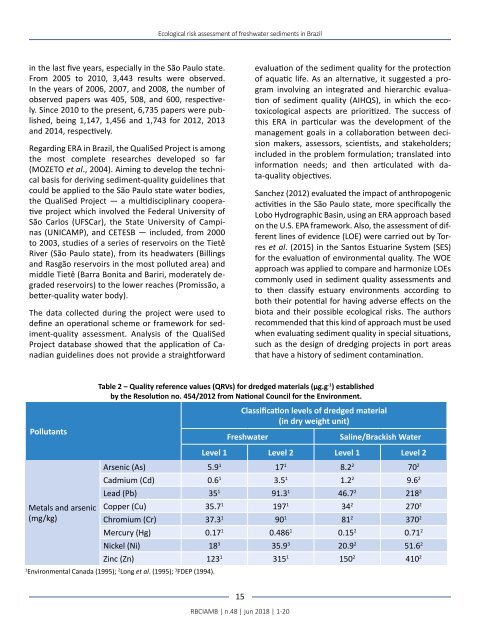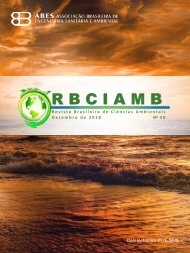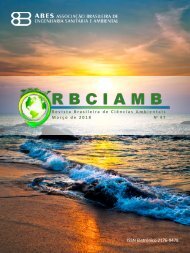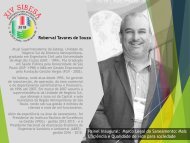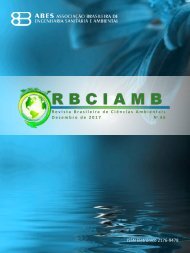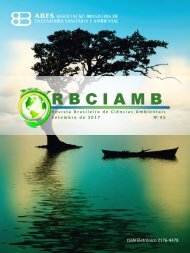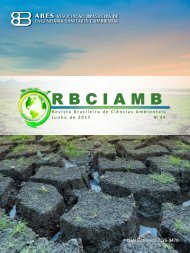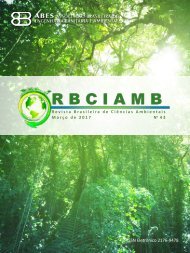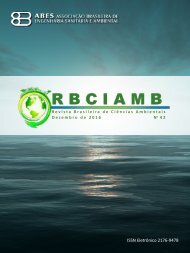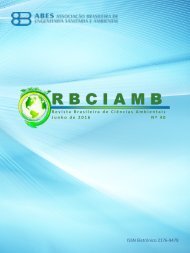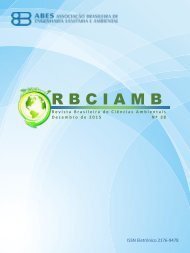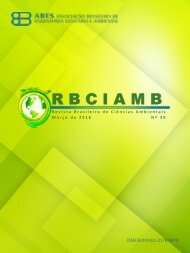Edição 48 RBCIAMB
You also want an ePaper? Increase the reach of your titles
YUMPU automatically turns print PDFs into web optimized ePapers that Google loves.
Ecological risk assessment of freshwater sediments in Brazil<br />
in the last five years, especially in the São Paulo state.<br />
From 2005 to 2010, 3,443 results were observed.<br />
In the years of 2006, 2007, and 2008, the number of<br />
observed papers was 405, 508, and 600, respectively.<br />
Since 2010 to the present, 6,735 papers were published,<br />
being 1,147, 1,456 and 1,743 for 2012, 2013<br />
and 2014, respectively.<br />
Regarding ERA in Brazil, the QualiSed Project is among<br />
the most complete researches developed so far<br />
(MOZETO et al., 2004). Aiming to develop the technical<br />
basis for deriving sediment-quality guidelines that<br />
could be applied to the São Paulo state water bodies,<br />
the QualiSed Project — a multidisciplinary cooperative<br />
project which involved the Federal University of<br />
São Carlos (UFSCar), the State University of Campinas<br />
(UNICAMP), and CETESB — included, from 2000<br />
to 2003, studies of a series of reservoirs on the Tietê<br />
River (São Paulo state), from its headwaters (Billings<br />
and Rasgão reservoirs in the most polluted area) and<br />
middle Tietê (Barra Bonita and Bariri, moderately degraded<br />
reservoirs) to the lower reaches (Promissão, a<br />
better-quality water body).<br />
The data collected during the project were used to<br />
define an operational scheme or framework for sediment-quality<br />
assessment. Analysis of the QualiSed<br />
Project database showed that the application of Canadian<br />
guidelines does not provide a straightforward<br />
evaluation of the sediment quality for the protection<br />
of aquatic life. As an alternative, it suggested a program<br />
involving an integrated and hierarchic evaluation<br />
of sediment quality (AIHQS), in which the ecotoxicological<br />
aspects are prioritized. The success of<br />
this ERA in particular was the development of the<br />
management goals in a collaboration between decision<br />
makers, assessors, scientists, and stakeholders;<br />
included in the problem formulation; translated into<br />
information needs; and then articulated with data-quality<br />
objectives.<br />
Sanchez (2012) evaluated the impact of anthropogenic<br />
activities in the São Paulo state, more specifically the<br />
Lobo Hydrographic Basin, using an ERA approach based<br />
on the U.S. EPA framework. Also, the assessment of different<br />
lines of evidence (LOE) were carried out by Torres<br />
et al. (2015) in the Santos Estuarine System (SES)<br />
for the evaluation of environmental quality. The WOE<br />
approach was applied to compare and harmonize LOEs<br />
commonly used in sediment quality assessments and<br />
to then classify estuary environments according to<br />
both their potential for having adverse effects on the<br />
biota and their possible ecological risks. The authors<br />
recommended that this kind of approach must be used<br />
when evaluating sediment quality in special situations,<br />
such as the design of dredging projects in port areas<br />
that have a history of sediment contamination.<br />
Table 2 – Quality reference values (QRVs) for dredged materials (µg.g -1 ) established<br />
by the Resolution no. 454/2012 from National Council for the Environment.<br />
Pollutants<br />
Classification levels of dredged material<br />
(in dry weight unit)<br />
Freshwater<br />
Saline/Brackish Water<br />
Level 1 Level 2 Level 1 Level 2<br />
Arsenic (As) 5.9 1 17 1 8.2 2 70 2<br />
Cadmium (Cd) 0.6 1 3.5 1 1.2 2 9.6 2<br />
Lead (Pb) 35 1 91.3 1 46.7 2 218 2<br />
Metals and arsenic Copper (Cu) 35.7 1 197 1 34 2 270 2<br />
(mg/kg)<br />
Chromium (Cr) 37.3 1 90 1 81 2 370 2<br />
Mercury (Hg) 0.17 1 0.<strong>48</strong>6 1 0.15 2 0.71 2<br />
Nickel (Ni) 18 3 35.9 3 20.9 2 51.6 2<br />
Zinc (Zn) 123 1 315 1 150 2 410 2<br />
1<br />
Environmental Canada (1995); 2 Long et al. (1995); 3 FDEP (1994).<br />
15<br />
<strong>RBCIAMB</strong> | n.<strong>48</strong> | jun 2018 | 1-20


